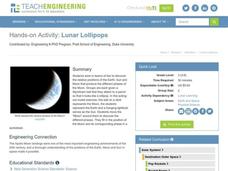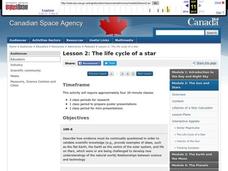University of Texas
Observing the Moon
Why does it look like there is a man on the moon? Why does the moon look different every night? These are the focus questions of a lesson that prompts class members to observe and record the nightly changes of Earth's natural satellite.
Peabody Essex Museum
Chinese New Year Celebrations
Gong He Xin Xi! Happy New Year! Planning a Lunar New Year/Spring Festival Celebration? Check out the activities and resources in a packet that encourages pupils to research the cultural values and traditional practices associated with...
Curated OER
Take Your Class to the Moon
Get your kids talking about our lunar neighbor with these hands-on lessons.
Curated OER
Doin' The Moonwalk
If you are looking for an outstanding instructional activity on the Moon for your budding astronomers, look no further! This outstanding plan is full of wonderful, meaningful activities for your charges to engage in. Pupils will discover...
Curated OER
The Life Cycle of a Butterfly
Students complete lessons on a butterfly life cycle, moon phases, hot water, and shadows. In this science lesson plan, students complete activities where they read books, look at demonstrations, and complete experiments.
Curated OER
Solar and Lunar Eclipses
Students complete a WebQuest in order to better explain solar and lunar eclipses. They observe images and videos of eclipses from around the world.
Curated OER
Clip the Face
Young scholars discover the moon's phases and the rarity of eclipses. In this lunar lesson, students view a video titled Spin Around the Solar System: A Moon Dance, which demonstrates the key differences between a lunar and solar...
Curated OER
Lunar Lollipops
Students work with a partner, Styrofoam ball and light source to simulate the positions of the Earth, Moon and Sun at various stages during the phases of the Moon. They describe why the Moon is visible from Earth and complete a worksheet.
NASA
Engineering Design for Human Exploration
What would it take to live on the lunar surface? Small groups build model rockets in order to simulate launching a habitat into space and rebuilding it. Divide the class into groups to design and build a model of a lunar habitat. The...
Curated OER
Phases of the Moon
Sixth graders learn that the moon orbits the Earth in a predictable cycle. Each learner engages in a two-week observation of the moon. They sketch its appearance, and take note of its position in relation to objects in their yard. Some...
ESL Holiday
Chinese New Year—ESL Lesson
Language learners read a passage about Chinese New Year celebrations and then complete a series of reading comprehension and grammar exercises based on the passage.
Curated OER
Regolith Formation
Students study what regolith is and how it contrasts with weathering on Earth. For this weathering lesson students divide into groups, hypothesize and confirm their guesses.
Curated OER
The Life Cycle of a Star
Students investigate the life cycle of a star and make conclusions based on evidence, research, and observation. In this lesson on space and scientific investigation, students describe the relationships between science and technology...
Columbus City Schools
Experiencing Eclipses
Don't be caught in the dark! Young scientists investigate the causes of both solar and lunar eclipses using an interactive to help them understand the development of an eclipse over time. They then research facts and characteristics of...
Curated OER
Your Day as a Cycle
Fourth graders investigate several cycles such as life cycles, and the moon cycle. They examine the sequences and patterns that are associated with daily life by keeping a daily journal for three days, and comparing it with others....
Mr. E. Science
The Earth in Space
Do you think Earth makes fun of other planets for having no life? The presentation covers the rotation and revolution of both the earth and our moon. It provides explanations for seasons, tides, and eclipses. Lesson is the 20th in a...
Curated OER
Lesson Plan # 1 - Phases of the Moon
Learners explore and identify moon phases, watch teacher demonstration of different phases using globe and flashlight to represent moon and sun, and discuss reasons why there are moon phases.
Columbus City Schools
Totally Tides
Surf's up, big kahunas! How do surfers know when the big waves will appear? They use science! Over the course of five days, dive in to the inner workings of tidal waves and learn to predict sea levels with the moon as your guide.
Curated OER
Thirteen Moons Language Lesson
First graders study, discuss, and memorize the meanings in the Oneida Language of the most commonly used names for each of the Thirteen Moon cycles in their community. They draw pictures corresponding with the name of each of the moon...
Curated OER
What Shape is the Moon Tonight?
Students understand that the moon appears differently throughout the month. In this phases of the moon lesson, students observe and record the phases of the moon.
Curated OER
Phases of the Moon Flip Book
Students make a flip book. In this moon lesson, students review the moon phases and how they occur. Students make a flip book to show the moon's motion around the Earth.
Curated OER
Phase In, Phase Out, the Magnificent Moon
First graders discuss why the moon appears to change shape. They use flashlights and balls to simulate the sun's light shining on the moon during its different phases. They read books, paint pictures and write sentences about the moon.
Curated OER
Exploring the Night Sky: Fall/Winter
Students explain how moon phases occur. They explain three ways that the night sky has been used through history. Students locate some of the constellations in the night sky. They discuss stories and myths surrounding stars.
Curated OER
Wax On, Wane Off
Students investigate the cycles of the moon through an in class experiment. In this lunar lesson plan, students utilize a tennis ball and their own head to simulate the moon and Earth and create moon phases by observing the tennis ball...

























